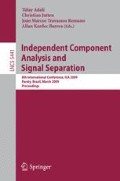Abstract
An often used approach for separating convolutive mixtures is the transformation to the time-frequency domain where an instantaneous ICA algorithm can be applied for each frequency separately. This approach leads to the so called permutation and scaling ambiguity. While different methods for the permutation problem have been widely studied, the solution for the scaling problem is usually based on the minimal distortion principle. We propose an alternative approach that shapes the unmixing filters to have an exponential decay which mimics the form of room impulse responses. These new filters still add some reverberation to the restored signals, but the audible distortions are clearly reduced. Additionally the length of the unmixing filters is reduced, so these filters will suffer less from circular-convolution effects that are inherent to unmixing approaches based on bin-wise ICA followed by permutation and scaling correction. The results for the new algorithm will be shown on a real-world example.
Access this chapter
Tax calculation will be finalised at checkout
Purchases are for personal use only
Preview
Unable to display preview. Download preview PDF.
References
Amari, S., Cichocki, A., Yang, H.H.: A new learning algorithm for blind signal separation. In: Touretzky, D.S., Mozer, M.C., Hasselmo, M.E. (eds.) Advances in Neural Information Processing Systems, vol. 8, pp. 757–763. MIT Press, Cambridge (1996)
Hyvärinen, A., Oja, E.: A fast fixed-point algorithm for independent component analysis. Neural Computation 9, 1483–1492 (1997)
Cardoso, J.F., Soulomiac, A.: Blind beamforming for non-Gaussian signals. Proc. Inst. Elec. Eng., pt. F. 140(6), 362–370 (1993)
Douglas, S.C., Sawada, H., Makino, S.: Natural gradient multichannel blind deconvolution and speech separation using causal FIR filters. IEEE Trans. Speech and Audio Processing 13(1), 92–104 (2005)
Aichner, R., Buchner, H., Araki, S., Makino, S.: On-line time-domain blind source separation of nonstationary convolved signals. In: Proc. 4th Int. Symp. on Independent Component Analysis and Blind Signal Separation (ICA 2003), Nara, Japan, pp. 987–992 (April 2003)
Smaragdis, P.: Blind separation of convolved mixtures in the frequency domain. Neurocomputing 22(1-3), 21–34 (1998)
Rahbar, K., Reilly, J.: A frequency domain method for blind source separation of convolutive audio mixtures. IEEE Trans. Speech and Audio Processing 13(5), 832–844 (2005)
Anemüller, J., Kollmeier, B.: Amplitude modulation decorrelation for convolutive blind source separation. In: Proceddings of the second international workshop on independent component analysis and blind signal separation, pp. 215–220 (2000)
Mazur, R., Mertins, A.: Solving the permutation problem in convolutive blind source separation. In: Davies, M.E., James, C.J., Abdallah, S.A., Plumbley, M.D. (eds.) ICA 2007. LNCS, vol. 4666, pp. 512–519. Springer, Heidelberg (2007)
Sawada, H., Mukai, R., Araki, S., Makino, S.: A robust and precise method for solving the permutation problem of frequency-domain blind source separation. IEEE Trans. Speech and Audio Processing 12(5), 530–538 (2004)
Wang, W., Chambers, J.A., Sanei, S.: A novel hybrid approach to the permutation problem of frequency domain blind source separation. In: Puntonet, C.G., Prieto, A.G. (eds.) ICA 2004. LNCS, vol. 3195, pp. 532–539. Springer, Heidelberg (2004)
Mukai, R., Sawada, H., Araki, S., Makino, S.: Blind source separation of 3-d located many speech signals. In: 2005 IEEE Workshop on Applications of Signal Processing to Audio and Acoustics, pp. 9–12 (October 2005)
Ikeda, S., Murata, N.: A method of blind separation based on temporal structure of signals. In: Proc. Int. Conf. on Neural Information Processing, pp. 737–742 (1998)
Matsuoka, K.: Minimal distortion principle for blind source separation. In: Proceedings of the 41st SICE Annual Conference, vol. 4, pp. 2138–2143, August 5-7 (2002)
Sawada, H., Mukai, R., de la Kethulle, S., Araki, S., Makino, S.: Spectral smoothing for frequency-domain blind source separation. In: International Workshop on Acoustic Echo and Noise Control (IWAENC 2003), pp. 311–314 (September 2003)
Arslan, G., Evans, B.L., Kiaei, S.: Equalization for discrete multitone transceivers to maximize bit rate. IEEE Trans. on Signal Processing 49(12), 3123–3135 (December)
Kallinger, M., Mertins, A.: Multi-channel room impulse response shaping - a study. In: Proc. IEEE Int. Conf. Acoust., Speech, and Signal Processing, Toulouse, France, vol. V, pp. 101–104 (May 2006)
Melsa, P., Younce, R., Rohrs, C.: Impulse response shortening for discrete multitone transceivers. IEEE Trans. on Communications 44(12), 1662–1672 (1996)
http://www.kecl.ntt.co.jp/icl/signal/sawada/demo/bss2to4/index.html
Author information
Authors and Affiliations
Editor information
Editors and Affiliations
Rights and permissions
Copyright information
© 2009 Springer-Verlag Berlin Heidelberg
About this paper
Cite this paper
Mazur, R., Mertins, A. (2009). A Method for Filter Shaping in Convolutive Blind Source Separation. In: Adali, T., Jutten, C., Romano, J.M.T., Barros, A.K. (eds) Independent Component Analysis and Signal Separation. ICA 2009. Lecture Notes in Computer Science, vol 5441. Springer, Berlin, Heidelberg. https://doi.org/10.1007/978-3-642-00599-2_36
Download citation
DOI: https://doi.org/10.1007/978-3-642-00599-2_36
Publisher Name: Springer, Berlin, Heidelberg
Print ISBN: 978-3-642-00598-5
Online ISBN: 978-3-642-00599-2
eBook Packages: Computer ScienceComputer Science (R0)

